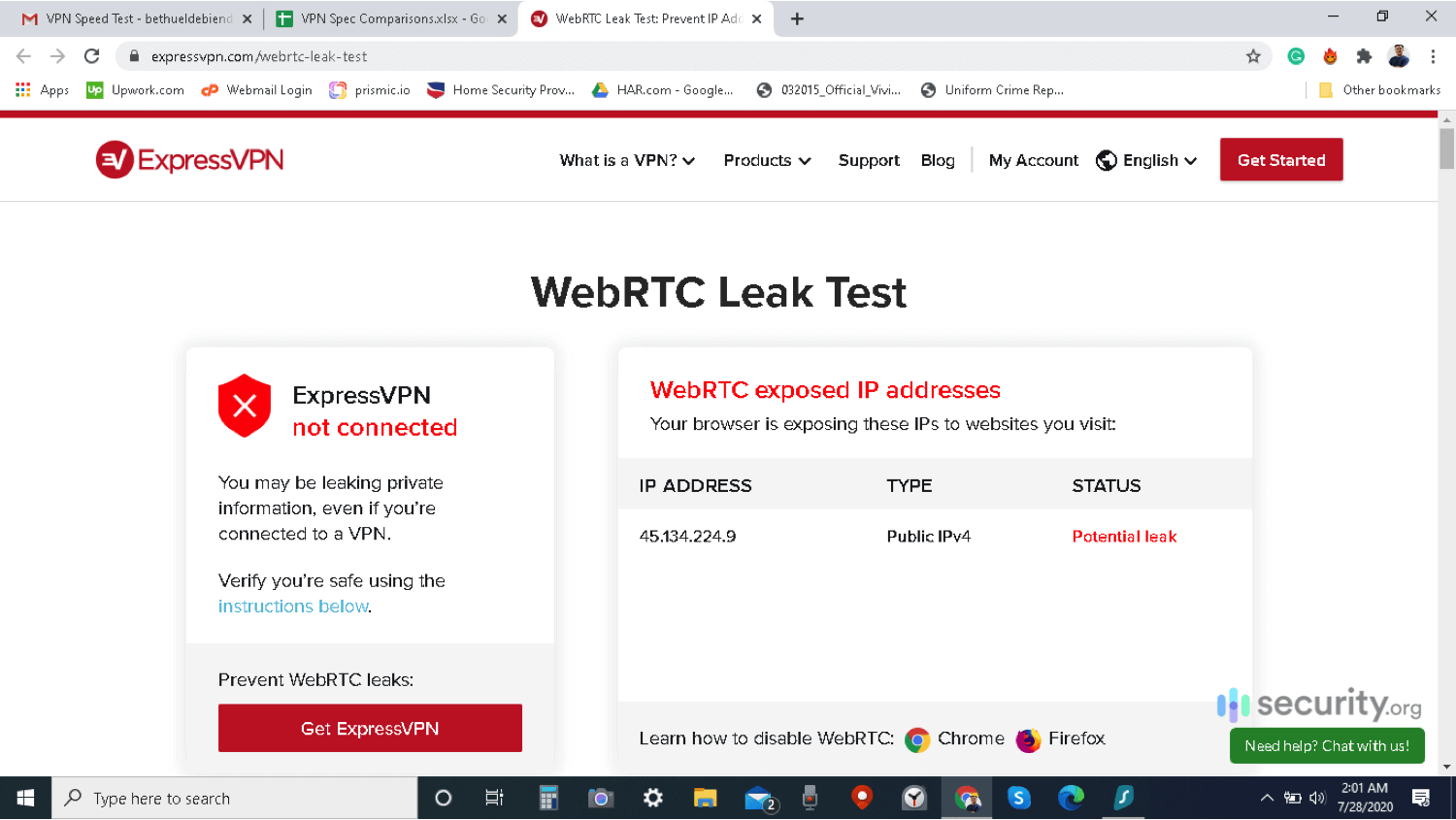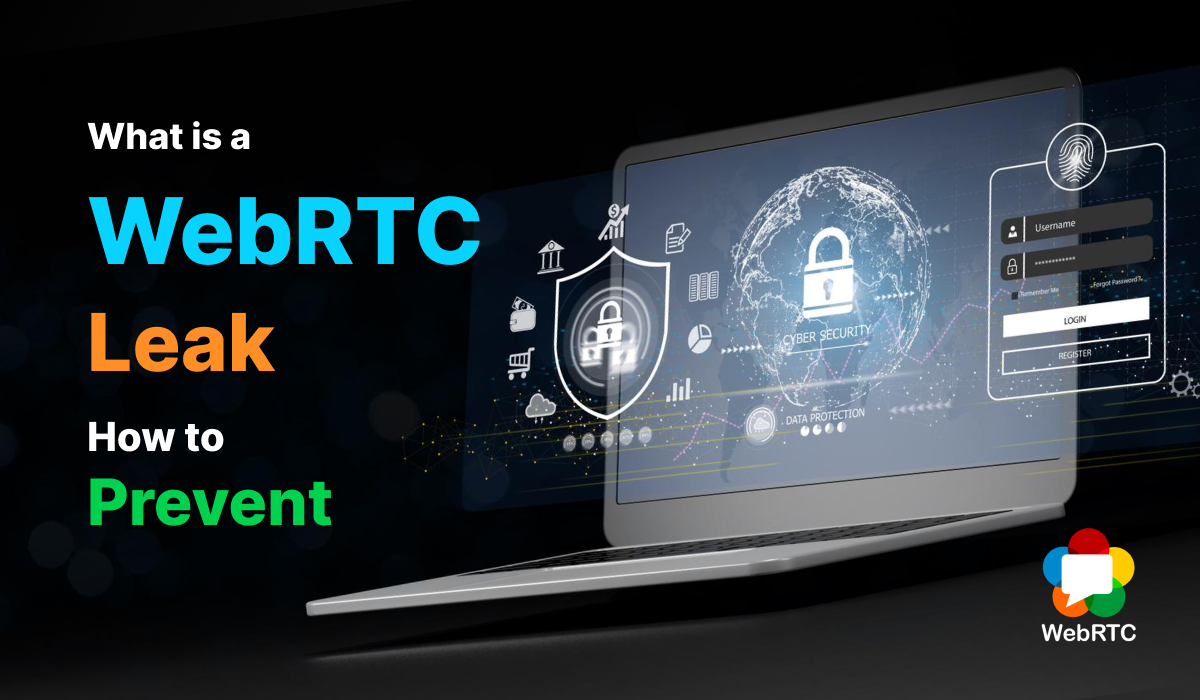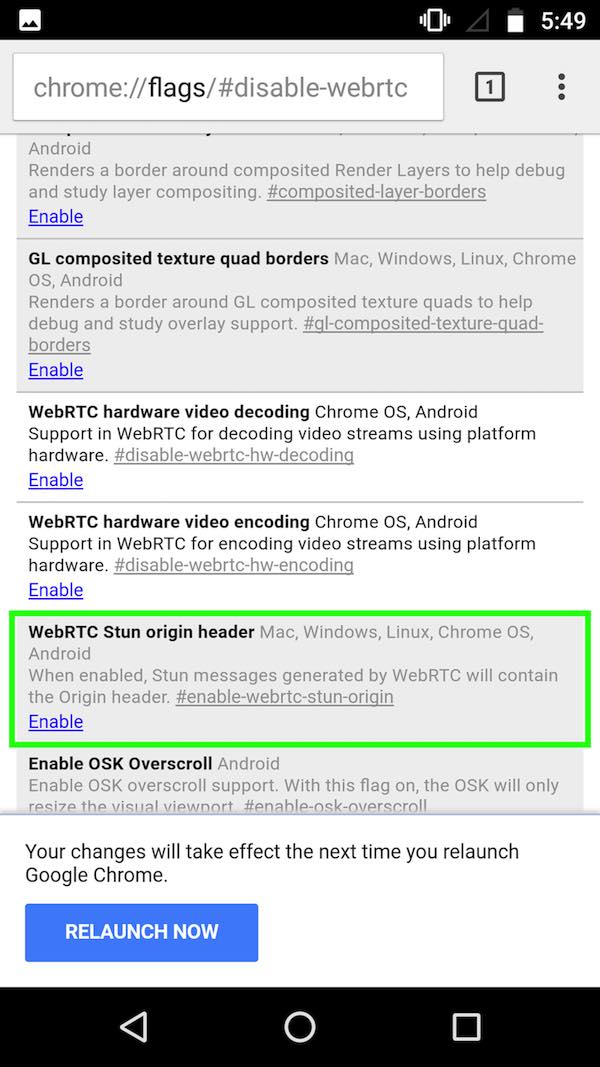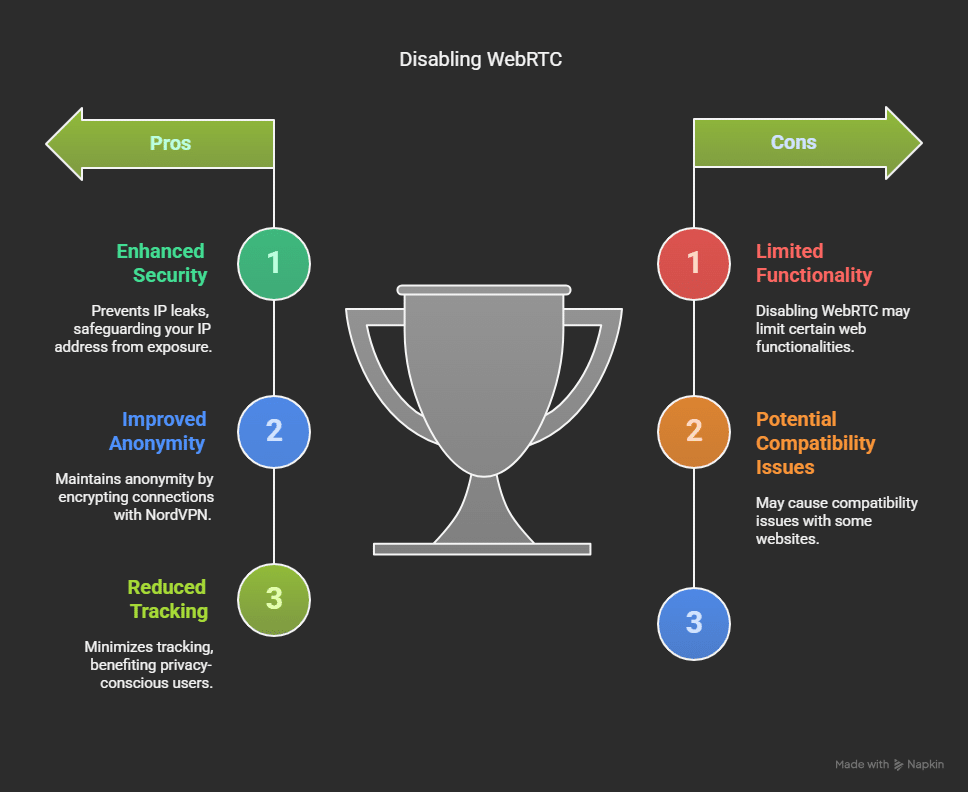To disable WebRTC and prevent leaks, follow these steps. WebRTC can expose your IP address, compromising your privacy.
WebRTC, or Web Real-Time Communication, allows browsers to communicate directly. It’s useful for video calls and file sharing. Still, it can also reveal your IP address, even if you’re using a VPN. This security flaw could expose your online activities to prying eyes. Disabling WebRTC can help protect your privacy and prevent potential leaks. This guide will show you how to disable WebRTC on various browsers and ensure your online activities remain private. For added security, consider using NordVPN, which offers advanced encryption and a strict no-logs policy.

Credit: www.security.org
Introduction To Webrtc And Privacy Concerns
WebRTC, or Web Real-Time Communication, is a powerful technology. It allows audio, video, and data sharing between browsers without plugins. While this sounds convenient, it can expose your IP address, leading to privacy issues. Understanding WebRTC and how it impacts your privacy is crucial for safe online activity.
Understanding Webrtc Technology
WebRTC stands for Web Real-Time Communication. This open-source project enables real-time communication directly from your web browser. WebRTC allows users to make voice calls, video chat, and share files.
Audio and Video: WebRTC supports real-time audio and video communication.
Data Channels: It allows peer-to-peer data sharing between browsers.
No Plugins: No need for external plugins or third-party software.
This technology is embedded in modern Chrome, Firefox, and Safari browsers. It is designed to provide seamless communication experiences. Yet, it comes with significant privacy concerns.
Common Privacy Issues With Webrtc
WebRTC can compromise your privacy by exposing your real IP address. Even if you use a VPN, WebRTC can bypass it and reveal your location.
Privacy Issue | Description |
|---|---|
IP Address Leak | WebRTC can expose your real IP address, even with a VPN. |
Location Disclosure | Your physical location can be revealed through your IP address. |
Unwanted Tracking | Trackers can use WebRTC to monitor your online activities. |
Using a VPN like NordVPN can help, but additional steps are necessary to disable WebRTC and prevent leaks.

Credit: meetrix.io
Key Features Of Webrtc And Their Privacy Implications
WebRTC (Web Real-Time Communication) is a powerful technology that enables direct communication between browsers. While it offers numerous advantages, it also has significant privacy implications. Understanding its key features can help you take measures to protect your privacy.
Real-time Communication Capabilities
WebRTC facilitates real-time audio, video, and data sharing directly between browsers. This capability is essential for video conferencing, online gaming, and live-streaming applications. It eliminates the need for third-party plugins, making communication more seamless and efficient.
However, these real-time communication capabilities can expose your IP address to peers, raising privacy concerns. An exposed IP address can lead to potential tracking and unauthorized access.
Peer-to-peer Connections
WebRTC enables direct peer-to-peer (P2P) connections, allowing data to bypass servers and travel directly between users. This feature enhances performance and reduces latency, making it ideal for real-time applications.
Despite the performance benefits, P2P connections can inadvertently leak your IP address. This leak can reveal your geographic location and potentially compromise your privacy. A VPN like NordVPN can mask your IP address, enhancing online security.
Browser Compatibility And Integration
WebRTC is integrated into most modern browsers, including Chrome, Firefox, and Safari. This widespread compatibility ensures that users enjoy seamless real-time communication across different platforms.
While this integration is convenient, it also means that the potential for IP leaks is present across multiple browsers. Disabling WebRTC in your browser settings or using browser extensions to block WebRTC can help mitigate these privacy risks.
Browser | Supports WebRTC | Disabling Method |
|---|---|---|
Chrome | Yes | Browser Extension |
Firefox | Yes | Settings/Browser Extension |
Safari | Yes | Settings |
Understanding these key features and their implications is crucial for maintaining online privacy. Utilizing tools like NordVPN can provide additional protection by masking your IP address and encrypting your internet connection.
Steps To Disable Webrtc In Different Browsers
WebRTC (Web Real-Time Communication) can expose your IP address, even when using a VPN. Disabling WebRTC ensures your online privacy and prevents potential leaks. Below are the steps to disable WebRTC in popular browsers like Google Chrome, Mozilla Firefox, Microsoft Edge, and Safari.
Disabling Webrtc In Google Chrome
Google Chrome doesn’t offer a built-in option to disable WebRTC. However, you can use a browser extension to block WebRTC leaks.
Open Chrome and go to the Chrome Web Store.
Search for extensions like “WebRTC Leak Prevent” or “uBlock Origin.”
Install the extension and enable it.
Go to the extension’s settings and ensure WebRTC is blocked.
Disabling Webrtc In Mozilla Firefox
Mozilla Firefox allows you to disable WebRTC directly from its settings without any extensions.
Open Firefox and type about: config in the address bar.
Click on “Accept the Risk and Continue”.
Search for media.peerconnection.enabled.
Double-click on the entry to change its value to false.
Disabling Webrtc In Microsoft Edge
Microsoft Edge, like Chrome, requires an extension to disable WebRTC.
Open Edge and go to the Edge Add-ons Store.
Search for “WebRTC Control” or similar extensions.
Install the extension and enable it.
Go to the extension’s settings and ensure WebRTC is blocked.
Disabling Webrtc In Safari
Safari users can disable WebRTC through the browser’s experimental features.
Open Safari and go to Preferences from the Safari menu.
Click on the Advanced tab.
Enable the checkbox for “Show Develop menu in the menu bar.”
From the Develop menu, go to Experimental Features.
Disable WebRTC mDNS ICE candidates by unchecking them.

Credit: cyberinsider.com
Using Browser Extensions To Prevent Webrtc Leaks
WebRTC leaks can compromise your privacy by exposing your real IP address. Browser extensions are an effective way to prevent these leaks. They block WebRTC from running in your browser, ensuring your IP stays hidden. Below, we explore the top extensions for Chrome and Firefox and how to configure and use them.
Top Extensions For Chrome
Extension Name | Description | Rating |
|---|---|---|
WebRTC Network Limiter | Limits WebRTC from revealing local IP addresses. | 4.5/5 |
WebRTC Leak Prevent | Prevents WebRTC leaks by disabling WebRTC in your browser. | 4.6/5 |
uBlock Origin | An ad blocker with WebRTC leak prevention features. | 4.7/5 |
Top Extensions For Firefox
Extension Name | Description | Rating |
|---|---|---|
Disable WebRTC | Completely disables WebRTC in Firefox. | 4.5/5 |
WebRTC Control | Allows you to toggle WebRTC on and off easily. | 4.6/5 |
uBlock Origin | An ad blocker with WebRTC leak prevention features. | 4.7/5 |
Configuring And Using These Extensions
Install the Extension: Search for the extension in your browser’s store. Click “Add to Chrome” or “Add to Firefox.”
Enable the Extension: Open the extension from the toolbar. Ensure it’s enabled to start blocking WebRTC.
Adjust Settings: Some extensions offer settings to fine-tune their functionality. Adjust these according to your needs.
Verify Protection: Visit a WebRTC leak test website. Check if your real IP address is hidden.
Using these browser extensions will help keep your online activity private. They are easy to install and configure, providing an extra layer of security. For a comprehensive solution, consider using a VPN service like NordVPN, which offers advanced encryption and a strict no-logs policy.
https://www.youtube.com/watch?v=jTmJoD_D4fM
Advanced Methods For Disabling Webrtc
WebRTC leaks can compromise your privacy. Suppose you want to enhance your online security, especially as a NordVPN user. In that case, understanding advanced methods to disable WebRTC is essential. This guide provides a detailed look at advanced techniques to prevent WebRTC leaks.
Editing Browser Configuration Files
You can directly edit the configuration files to gain more control over your browser’s behavior. This method requires some technical knowledge but offers a permanent solution.
Firefox:
Type about: config in the address bar.
Search for media.peerconnection.enabled.
Set the value to false.
Chrome:
Navigate to chrome://flags.
Search for WebRTC.
Disable relevant flags such as the WebRTC STUN origin header.
Editing these settings helps disable WebRTC directly from your browser, ensuring no leaks can compromise your privacy.
Using System-level Network Settings
Another advanced method involves adjusting system-level network settings. This approach not only secures your browser but also enhances overall network security.
Operating System | Steps |
|---|---|
Windows |
|
macOS |
|
Adjusting these settings ensures that your entire system is protected, reducing the chances of WebRTC leaks regardless of your browser.
Pros And Cons Of Disabling Webrtc
Disabling WebRTC can significantly enhance your online privacy. However, it might also affect your browsing experience. Let’s explore the benefits and potential drawbacks.
Benefits Of Enhanced Privacy
Improved Security: Disabling WebRTC can prevent IP leaks. This helps safeguard your IP address from being exposed to websites or third parties.
Better Anonymity: With WebRTC disabled, you can maintain a higher level of anonymity while browsing, especially when using NordVPN. The VPN encrypts your connection, ensuring no one can track your online activities.
Reduced Risk of Tracking: By disabling WebRTC, you minimize the risk of websites tracking your location or other personal information. This is especially beneficial for privacy-conscious users.

Potential Drawbacks And Workarounds
Limited Functionality: Some web applications rely on WebRTC for real-time communication. Disabling it might affect features like video calls or live chats.
Workaround: Use browser extensions to selectively enable WebRTC for trusted sites. This way, you can maintain functionality while protecting your privacy.
Reduced Performance: Disabling WebRTC can sometimes lead to a slower browsing experience, especially on websites optimized for this technology.
Workaround: Ensure you are using a high-speed VPN service like NordVPN. With over 7400 servers and high connection speeds, NordVPN can help minimize any performance impact.
Compatibility Issues: Disabling WebRTC might cause compatibility issues with specific browsers or services that depend on it for functionality.
Workaround: Use browser settings or extensions to manage WebRTC per site. This allows you to balance functionality and privacy.
Specific Recommendations For Ideal Users
Disabling WebRTC can significantly improve your online privacy. Certain users benefit more from this adjustment. Here are some specific recommendations for ideal users.
Who Should Consider Disabling Webrtc?
Privacy-Conscious Individuals: Those who value their online privacy should disable WebRTC. WebRTC can expose your IP address, even when using a VPN.
Journalists and Activists: These groups often handle sensitive information. Disabling WebRTC can prevent potential leaks that compromise their safety.
Users in Censored Regions: People in countries with strict internet censorship can benefit from disabling WebRTC. It helps maintain anonymity and access restricted content securely.
Scenarios Where Disabling Webrtc Is Crucial
Using Public Wi-Fi: Public Wi-Fi networks are often insecure. Disabling WebRTC adds an extra layer of security, protecting your data from potential hackers.
Streaming and Torrenting: WebRTC leaks can expose your IP address, affecting your streaming and torrenting activities. Disabling it ensures these activities remain private.
Bypassing Geo-Restrictions: WebRTC leaks can reveal your real location when accessing geo-blocked content. Disabling WebRTC helps maintain access to restricted content.
NordVPN, with its advanced encryption and no-logs policy, supports disabling WebRTC. It ensures your privacy and security, whether streaming, torrenting, or accessing geo-blocked content.
Feature | Description |
|---|---|
High Connection Speed | Over 6730+ Mbps. |
VPN Servers | More than 7400 servers across 118 countries. |
Next-Generation Encryption | A-256 encryption to keep data safe. |
Malware Protection | Threat Protection feature scans downloads for malware, blocks trackers, and hides ads. |
Strict No-Log Policy | No collection or storage of private information. |
Multiple Device Support | One account can secure ten devices. |
Easy Setup | Quick Connect button for fast and easy server connection. |
For more information or to purchase NordVPN, visit their website.
Conclusion And Final Thoughts
Disabling WebRTC is essential for maintaining privacy. It prevents IP address leaks and keeps your online activity secure. Ensuring you have robust measures can protect you from potential threats.
Recap Of Key Points
WebRTC can expose your real IP address, even when using a VPN.
Disabling WebRTC is crucial for protecting your privacy online.
Using browser settings or extensions can help disable WebRTC.
NordVPN offers advanced security features to enhance your online protection.
Final Recommendations For Ensuring Privacy
To ensure your privacy, follow these recommendations:
Use a Reliable VPN: NordVPN offers double encryption and a strict no-logs policy. It keeps your data secure with AES-256 encryption.
Disable WebRTC: Adjust your browser settings or install WebRTC-blocking extensions. This prevents IP leaks.
Regularly Update Software: Keep your browsers and VPN software updated. This ensures you have the latest security patches.
Enable Threat Protection: Use NordVPN’s threat protection to block ads, trackers, and malware. This adds an extra layer of security.
Secure Multiple Devices: NordVPN supports up to ten devices on one account. Ensure all your devices are protected.
For a seamless experience, consider using NordVPN. It provides fast connections, robust security, and easy setup. Whether streaming, torrenting, or browsing, NordVPN keeps your data safe.
For more information, visit the NordVPN website.
Frequently Asked Questions
How To Stop Webrtc Ip Leakage?
Use a VPN to mask your IP address. Disable WebRTC in your browser settings. Install browser extensions like uBlock Origin.
Which Vpn Blocks Webrtc?
NordVPN, ExpressVPN, and CyberGhost block WebRTC effectively. These VPNs prevent IP leaks and ensure online privacy.
What Causes Webrtc Leaks?
WebRTC leaks occur due to browser settings revealing your real IP address during peer-to-peer communication. This compromises privacy and security.
How Do I Block Webrtc Router?
To block WebRTC on your router, access the router settings. Disable WebRTC through the security or advanced settings tab. Use browser extensions like uBlock Origin to block WebRTC leaks for added protection.
Conclusion
Protecting your online privacy is essential. Disabling WebRTC can prevent leaks. This step ensures safer browsing. For added security, consider using NordVPN. It offers advanced encryption and a strict no-logs policy. NordVPN secures multiple devices with one account. Enjoy a safer internet experience. Click here to explore NordVPN’s features. Stay secure and protect your data.
